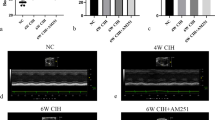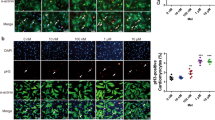Abstract
To explore the mechanism of a new type of melatonin receptor agonist Neu-p11 in hypoxia–reoxygenation injury of myocardial cells. Hypoxia/reoxygenation (H/R) model of H9c2 myocardial cells was established, and the cells were divided into control group, H/R group, and Neu-p11 group. Apoptosis rates of myocardial cells in different groups, the contents of creatinine kinase (CK), lactic dehydrogenase (LDH), superoxide dismutase (SOD), and malondialdehyde (MDA) in cell culture media were compared. Myocardial cells in control group showed diverse shape, and the refractivity of cells were high and the pulse was strong with synchronous rhythm of 60–80/min; The refractivity of myocardial cells in H/R group decreased, the pseudopodium was thinner, and the rhythm was reduced to 30–40/min; The morphology and refractivity of myocardial cells in Neu-p11 group were significantly improved with rhythm of 50–60/min. The apoptosis rates in the control group, the H/R group, and the Neu-p11 group were 2.48, 39.66, and 17.94 %, respectively. Levels of CK, LDH, and MDA were significantly decreased in Neu-p11 compared with H/R group, yet, both of which were significantly higher than that in control group. The SOD level was significantly lower in H/R group compared to that in control group, and Neu-p11 group with no statistical difference between the Neu-p11 group and the control group. Neu-p11 has protective effects on hypoxia–reoxygenation injury of myocardial cells. It inhibits cell apoptosis and improves the morphology and rhythm of myocardial cells; It alleviates injury of cell membrane by reducing its permeability, which can stabilize myocardial cell membrane; It also alleviates lipid peroxidation and protects mitochondria from myocardial ischemia/reperfusion injury.


Similar content being viewed by others
References
Kawaguchi, M., Takahashi, M., Hata, T., Kashima, Y., Usui, F., Morimoto, H., et al. (2011). Inflammasome activation of cardiac fibroblasts is essential for myocardial ischemia/reperfusion injury. Circulation, 123(6), 594–604.
Lai, R. C., Arslan, F., Lee, M. M., Sze, N. S., Choo, A., Chen, T. S., et al. (2010). Exosome secreted by MSC reduces myocardial ischemia/reperfusion injury. Stem Cell Research, 4(3), 214–222.
Turer, A. T., & Hill, J. A. (2010). Pathogenesis of myocardial ischemia–reperfusion injury and rationale for therapy. The American Journal of Cardiology, 106(3), 360–368.
Galano, A., Tan, D. X., & Reiter, R. J. (2011). Melatonin as a natural ally against oxidative stress: A physicochemical examination. Journal of Pineal Research, 51(1), 1–16.
Bonnefond, A., Clement, N., Fawcett, K., Yengo, L., Vaillant, E., Guillaume, J. L., et al. (2012). Rare MTNR1B variants impairing melatonin receptor 1B function contribute to type 2 diabetes. Nature Genetics, 44(3), 297–301.
McMullan, C. J., Schernhammer, E. S., Rimm, E. B., Hu, F. B., & Forman, J. P. (2013). Melatonin secretion and the incidence of type 2 diabetes. JAMA, The Journal of the American Medical Association, 309(13), 1388–1396.
Tan, D. X., Manchester, L. C., Fuentes-Broto, L., Paredes, S. D., & Reiter, R. J. (2011). Significance and application of melatonin in the regulation of brown adipose tissue metabolism: Relation to human obesity. Obesity Reviews, 12(3), 167–188.
Tian, S. W., Laudon, M., Han, L., Gao, J., Huang, F. L., Yang, Y. F., et al. (2010). Antidepressant- and anxiolytic effects of the novel melatonin agonist Neu-P11 in rodent models. Acta Pharmacologica Sinica, 31(7), 775–783.
Li, X., Cai, S., Yin, W., & Hu, X. (2013). Neu-p11 reduces clock/apelin expression in insulin-resistant mouse adipocyte model. Acta Biochimica et Biophysica Sinica, 45(9), 798–800.
She, M., Deng, X., Guo, Z., Laudon, M., Hu, Z., Liao, D., et al. (2009). NEU-P11, a novel melatonin agonist, inhibits weight gain and improves insulin sensitivity in high-fat/high-sucrose-fed rats. Pharmacological Research, 59(4), 248–253.
Kin, H., Zhao, Z. Q., Sun, H. Y., Wang, N. P., Corvera, J. S., Halkos, M. E., et al. (2004). Postconditioning attenuates myocardial ischemia–reperfusion injury by inhibiting events in the early minutes of reperfusion. Cardiovascular Research, 62(1), 74–85.
Reiter, R. J., Tan, D. X., Osuna, C., & Gitto, E. (2000). Actions of melatonin in the reduction of oxidative stress. A review. Journal of Biomedical Science, 7(6), 444–458.
Mann, G. E., Niehueser-Saran, J., Watson, A., Gao, L., Ishii, T., de Winter, P., et al. (2007). Nrf2/ARE regulated antioxidant gene expression in endothelial and smooth muscle cells in oxidative stress: Implications for atherosclerosis and preeclampsia. Sheng li xue bao : [Acta physiologica Sinica], 59(2), 117–127.
Tan, D. X., Manchester, L. C., Terron, M. P., Flores, L. J., & Reiter, R. J. (2007). One molecule, many derivatives: A never-ending interaction of melatonin with reactive oxygen and nitrogen species? Journal of Pineal Research, 42(1), 28–42.
Claustrat, B., Brun, J., & Chazot, G. (2005). The basic physiology and pathophysiology of melatonin. Sleep Medicine Reviews, 9(1), 11–24.
Dubocovich, M. L., & Markowska, M. (2005). Functional MT1 and MT2 melatonin receptors in mammals. Endocrine, 27(2), 101–110.
Ong, S. B., Subrayan, S., Lim, S. Y., Yellon, D. M., Davidson, S. M., & Hausenloy, D. J. (2010). Inhibiting mitochondrial fission protects the heart against ischemia/reperfusion injury. Circulation, 121(18), 2012–2022.
Tomas-Zapico, C., & Coto-Montes, A. (2005). A proposed mechanism to explain the stimulatory effect of melatonin on antioxidative enzymes. Journal of Pineal Research, 39(2), 99–104.
Olie, J. P., & Kasper, S. (2007). Efficacy of agomelatine, a MT1/MT2 receptor agonist with 5-HT2C antagonistic properties, in major depressive disorder. International Journal of Neuropsychopharmacology, 10(5), 661–673.
Hickie, I. B., & Rogers, N. L. (2011). Novel melatonin-based therapies: Potential advances in the treatment of major depression. Lancet, 378(9791), 621–631.
Ngoh, G. A., Facundo, H. T., Hamid, T., Dillmann, W., Zachara, N. E., & Jones, S. P. (2009). Unique hexosaminidase reduces metabolic survival signal and sensitizes cardiac myocytes to hypoxia/reoxygenation injury. Circulation Research, 104(1), 41–49.
Williamson, C. L., Dabkowski, E. R., Dillmann, W. H., & Hollander, J. M. (2008). Mitochondria protection from hypoxia/reoxygenation injury with mitochondria heat shock protein 70 overexpression. American Journal of Physiology Heart and Circulatory Physiology, 294(1), H249–H256.
Woo, A. Y., Waye, M. M., Tsui, S. K., Yeung, S. T., & Cheng, C. H. (2008). Andrographolide up-regulates cellular-reduced glutathione level and protects cardiomyocytes against hypoxia/reoxygenation injury. The Journal of Pharmacology and Experimental Therapeutics, 325(1), 226–235.
Dhar-Mascareno, M., Carcamo, J. M., & Golde, D. W. (2005). Hypoxia–reoxygenation-induced mitochondrial damage and apoptosis in human endothelial cells are inhibited by vitamin C. Free Radical Biology Medicine, 38(10), 1311–1322.
Woo, A. Y., Cheng, C. H., & Waye, M. M. (2005). Baicalein protects rat cardiomyocytes from hypoxia/reoxygenation damage via a prooxidant mechanism. Cardiovascular Research, 65(1), 244–253.
Ding, J., Li, Q. Y., Yu, J. Z., Wang, X., Sun, C. H., Lu, C. Z., et al. (2010). Fasudil, a Rho kinase inhibitor, drives mobilization of adult neural stem cells after hypoxia/reoxygenation injury in mice. Molecular Cellular Neurosciences, 43(2), 201–208.
Acknowledgments
This study was supported by the Research Foundation of Education Bureau of Zhejiang Province, China (Grant No. Y201328463).
Conflict of interest
The authors have no conflicts of interest to declare.
Author information
Authors and Affiliations
Corresponding author
Rights and permissions
About this article
Cite this article
Yu, J., Wei, J., Ji, L. et al. Exploration on Mechanism of a New Type of Melatonin Receptor Agonist Neu-p11 in Hypoxia–Reoxygenation Injury of Myocardial Cells. Cell Biochem Biophys 70, 999–1003 (2014). https://doi.org/10.1007/s12013-014-0009-2
Published:
Issue Date:
DOI: https://doi.org/10.1007/s12013-014-0009-2




